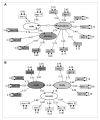Factors Influencing Burnout in Croatian Medical Students: The roles of Lifelong Learning and Loneliness
- PMID: 40385700
- PMCID: PMC12082462
- DOI: 10.5334/pme.1468
Factors Influencing Burnout in Croatian Medical Students: The roles of Lifelong Learning and Loneliness
Abstract
Background: Burnout and engagement are seen as opposite ends of a continuum. In medical education, engagement reflects motivation and social belonging, while burnout signifies a lack of interest in learning and social detachment. This study aimed to investigate the influence of lifelong learning and loneliness on these dynamics.
Methods: A cross-sectional study involving a culture back-translation procedure was performed. Participants were medical students enrolled in a Croatian medical school. The Maslach Burnout Inventory (MBI-GS), Jefferson Scale of Physician lifelong learning (JeffSPLL-MS), and the Scale of Social and Emotional Loneliness Scale for Adults (SELSA-S), were used as main measures. Sex, age, grade point average, and year of study, were collected in a complementary form. Confirmatory Factor Analyses (CFAs), followed by correlation, comparative and multiple linear regression analyses were performed to assess the above-mentioned variables.
Results: The sample consisted of 1,371 medical students (872 women), all native Croatian speakers. A model including lifelong learning, loneliness and sex variables accounted for 17% of the variance in the global MBI-GS score. This model showed a medium-to-large effect size and fulfilled conditions required for statistical inference. Additionally, differences by sex appeared in loneliness (p < 0.001), but not in lifelong learning abilities. Furthermore, the Croatian versions of the JeffSPLL-MS and the SELSA-S exhibited good psychometric properties, as confirmed by CFAs.
Conclusions: These findings highlight the influence of lifelong learning abilities and loneliness on the burnout-engagement continuum. Additionally, findings indicate that female medical students are at heightened risk of experiencing burnout.
Copyright: © 2025 The Author(s).
Conflict of interest statement
The authors have no competing interests to declare.
Figures


Similar articles
-
Burnout in International Medical Students: Characterization of Professionalism and Loneliness as Predictive Factors of Burnout.Int J Environ Res Public Health. 2022 Jan 26;19(3):1385. doi: 10.3390/ijerph19031385. Int J Environ Res Public Health. 2022. PMID: 35162399 Free PMC article.
-
A Rasch Analysis Validation of the Maslach Burnout Inventory-Student Survey with Preclinical Medical Students.Teach Learn Med. 2019 Apr-May;31(2):154-169. doi: 10.1080/10401334.2018.1523010. Epub 2018 Dec 21. Teach Learn Med. 2019. PMID: 30577705
-
Burnout and study engagement among medical students at Sun Yat-sen University, China: A cross-sectional study.Medicine (Baltimore). 2018 Apr;97(15):e0326. doi: 10.1097/MD.0000000000010326. Medicine (Baltimore). 2018. PMID: 29642167 Free PMC article.
-
Measuring medical students' orientation toward lifelong learning: a psychometric evaluation.Acad Med. 2010 Oct;85(10 Suppl):S41-4. doi: 10.1097/ACM.0b013e3181ed1ae9. Acad Med. 2010. PMID: 20881701
-
Correlates of burnout and dropout intentions in medical students: A cross-sectional study.J Affect Disord. 2024 Nov 1;364:221-230. doi: 10.1016/j.jad.2024.08.003. Epub 2024 Aug 10. J Affect Disord. 2024. PMID: 39128773 Review.
References
-
- Schaufeli WB, Martínez IM, Pinto AM, Salanova M, Bakker AB. Burnout and Engagement in University Students. J Cross Cult Psychol. 2002;33:464–81. DOI: 10.1177/0022022102033005003 - DOI
MeSH terms
LinkOut - more resources
Full Text Sources

